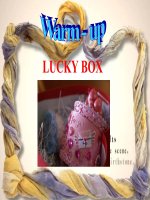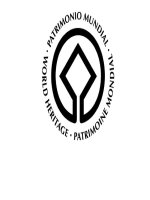- Trang chủ >>
- Sư phạm >>
- Sư phạm sử
Unit 16 Inventions
Bạn đang xem bản rút gọn của tài liệu. Xem và tải ngay bản đầy đủ của tài liệu tại đây (204.18 KB, 7 trang )
LỚP HỌC TT102
Địa chỉ: 23/176 Nguyễn Lân - Thanh Xuân - Hà Nội
Fanpage: Lớp học TT102 - Hotline: 094 494 0880 - Zalo: 094 494 0880
UNIT 16 - INVENTIONS
LISTEN AND READ
Tim Jones, Hoa’s American pen pal is visiting a chocolate factory with his class and his
teacher, Mrs. Allen. Mr. Roberts, the factory foreman, is showing them around.
Mr. Roberts: This is where the cacao beans are stored. Now follow me and I’ll show you the
first step in the manufacturing process.
Tim: Sam, what do you think this button is for? ,
Sam: I have no idea.
Mrs. Allen: Tim! Sam! Come here!
Mr. Roberts: Children, don’t touch that button! Now, the beans are washed, weighed, and
cooked here.
Mrs. Allen: Tim, come and stand beside me. I told you to behave!
Mr. Roberts: After the shells are removed, the beans are crushed and liquified. Cocoa butter
is added, along with sugar, vanilla and milk. Then the mixture is around, rolled and poured/
into molds.
Tim: It looks delicious.
Sam: Can we taste any?
Mr. Roberts: Yes, there’s some beside the conveyor belt.
Match the half-sentences. Then write the full sentences in Your exercise book.
a)
The beans are cleaned A. the cacao beans smell like chocolate.
b) Mr. Roberts thought
B. one of the ingredients in chocolate.
c)
C. Tim and Sam were going to touch the button.
After cooking,
PRACTICE
I.
Chọn động từ để điền vào chỗ trống, chú ý chia động từ phù hợp:
1.
make
grind
touch
drain
The zipper ............ by W.L. Judson in 1839.
2.
Coffee beans ............ usually ............ into powder.
3.
Look! Your bureau ............ to another site.
4.
Wine ............ from grapes.
5.
The computer ............ since 1946.
6.
This is the storehouse where the cocoa beans ............
7.
All the oil ............ from the engine by the mechanic half an hour ago.
Sưu tầm và đáp án: Đào Trọng Linh
store
use
remove
invent
1
LỚP HỌC TT102
Địa chỉ: 23/176 Nguyễn Lân - Thanh Xuân - Hà Nội
Fanpage: Lớp học TT102 - Hotline: 094 494 0880 - Zalo: 094 494 0880
8.
Children, that button cannot ............ ! It’s very dangerous.
II. Chuyển các câu sau sang bị động:
1.
Alexandra Bain invented the facsimile in 1843
................................................................................................................................................
2.
They dry the beans in the sun.
................................................................................................................................................
3.
People can make payment at any post office
................................................................................................................................................
4.
How do people learn English?
................................................................................................................................................
5.
They are going to build a new supermarket next year.
................................................................................................................................................
6.
Where did you take these photographs?
................................................................................................................................................
7.
The foreman is showing the students around the factory.
................................................................................................................................................
8.
I will translate the instructions into French.
................................................................................................................................................
9.
Has the council postponed the meeting?
................................................................................................................................................
10. They were cleaning the room when I arrived.
................................................................................................................................................
11. We haven’t finished our homework yet.
................................................................................................................................................
12. People say the computer is one of the most important inventions.
................................................................................................................................................
III. Chia động từ trong ngoặc (có dạng chủ động và bị động)
1.
There is somebody walking behind us. I think we (follow) ............
2.
Every time I print a document, the printer (break) ............ down.
3.
Apples (say) ............ to be good for our health.
4.
Hoa (bear) ............ in Hue but she (grow) ............ up in Hanoi.
5.
“Is Thanh’s house still for sale?” – “No, it (sell) ............ since last month.”
6.
The application form should (send) ............ today so that I (arrive) ............ the next day.
Sưu tầm và đáp án: Đào Trọng Linh
2
LỚP HỌC TT102
Địa chỉ: 23/176 Nguyễn Lân - Thanh Xuân - Hà Nội
Fanpage: Lớp học TT102 - Hotline: 094 494 0880 - Zalo: 094 494 0880
7.
How ............ cakes (make) ............? ............ you (ever/ make) ............?
8.
I (see) ............ an accident last night. Somebody (call) ............ an ambulance but nobody
(injure) ............ so the ambulance (not/ need) ............
9.
“Who (invent) ............ the microphone?” “It (invent) ............ by D.E. Hughes in 1878.”
10. The printer (break) ............ down yesterday, but now it’s OK. It (work) ............ again; it
(repair) ............
IV. Chọn đáp án đúng nhất
1.
A Chinese official made paper (of/ in/ from/ on) wood in 105.
2.
The first papermaking machine was invented (at/ in/ on/ from) the late 1700s (from/ of/
by/ to) a Frenchman.
3.
The factory foreman is showing them (round/ to/ in/ into) the factory.
4.
“What is this button (in/ beside/ like/ for)?” – “It’s used to operate the machine.”
5.
“Who(m) was the helicopter invented (for/ of/ from/ by)?” – “Igor Sikorsky”
6.
Don’t go away. Come and stand (besides/ inside/ beside/ next) me.
7.
Cocoa butter is added, along (to/ of/ with/ in) sugar, vanilla and milk.
8.
Pour a little milk (in/ from/ out/ into) my cup of coffer, please.
V. Đọc đoạn văn và xác định các câu dưới đúng hay sai
Scientists define a robot as a machine body which is operated by a computer, working
independently on human and capable of doing different jobs. Robots are invented to make our
work easier, by moving materials, tools and other objects through programmed actions.
Most robots look like giant arms, having the movement of the human arm and hand. The
robots are linked to a computer that controls them. A scientist can make the robots useful for a
variety of tasks. Robots are designed to move in a different ways. They can turn, pick up
objects and put them down. To do all these, the robots can move from side, up and down,
forwards and back.
1. Robots are actually people
2. Robots can not work when there is nobody to look after.
3. Robots help people to work.
4. Robots are controlled by computers.
5. Robots can be made to be useful for every task.
6. Robots can do many of the things humans do.
Sưu tầm và đáp án: Đào Trọng Linh
3
LỚP HỌC TT102
Địa chỉ: 23/176 Nguyễn Lân - Thanh Xuân - Hà Nội
Fanpage: Lớp học TT102 - Hotline: 094 494 0880 - Zalo: 094 494 0880
UNIT 16 - INVENTIONS
LISTEN AND READ
Tim Jones, Hoa’s American pen pal is visiting a chocolate factory with his class and his
teacher, Mrs. Allen. Mr. Roberts, the factory foreman, is showing them around.
Sưu tầm và đáp án: Đào Trọng Linh
4
LỚP HỌC TT102
Địa chỉ: 23/176 Nguyễn Lân - Thanh Xuân - Hà Nội
Fanpage: Lớp học TT102 - Hotline: 094 494 0880 - Zalo: 094 494 0880
Mr. Roberts: This is where the cacao beans are stored. Now follow me and I’ll show you the
first step in the manufacturing process.
Tim: Sam, what do you think this button is for? ,
Sam: I have no idea.
Mrs. Allen: Tim! Sam! Come here!
Mr. Roberts: Children, don’t touch that button! Now, the beans are washed, weighed, and
cooked here.
Mrs. Allen: Tim, come and stand beside me. I told you to behave!
Mr. Roberts: After the shells are removed, the beans are crushed and liquified. Cocoa butter
is added, along with sugar, vanilla and milk. Then the mixture is around, rolled and poured/
into molds.
Tim: It looks delicious.
Sam: Can we taste any?
Mr. Roberts: Yes, there’s some beside the conveyor belt.
Match the half-sentences. Then write the full sentences in Your exercise book.
a) The beans, one of the ingredents in chocolate, are cleaned.
b) Mr. Roberts thought Tim and Sam were going to touch the button.
c)
After cooking, the cacao beans smell like chocolate.
PRACTICE
I.
Chọn động từ để điền vào chỗ trống, chú ý chia động từ phù hợp:
1.
make
grind
store
touch
drain
use
The zipper was invented by W.L. Judson in 1839.
2.
Coffee beans are usually ground into powder.
3.
Look! Your bureau is made to another site.
4.
Wine has been used from grapes.
5.
The computer has been used since 1946.
6.
This is the storehouse where the cocoa beans are stored.
7.
All the oil drained from the engine by the mechanic half an hour ago.
8.
Children, that button cannot be touched! It’s very dangerous.
remove
invent
II. Chuyển các câu sau sang bị động:
1.
Alexandra Bain invented the facsimile in 1843
The fascimile was invented by Alexandra Bain in 1843.
Sưu tầm và đáp án: Đào Trọng Linh
5
LỚP HỌC TT102
Địa chỉ: 23/176 Nguyễn Lân - Thanh Xuân - Hà Nội
Fanpage: Lớp học TT102 - Hotline: 094 494 0880 - Zalo: 094 494 0880
2.
They dry the beans in the sun.
The beans are dried in the sun.
3.
People can make payment at any post office
Payment can be made at any post office.
4.
How do people learn English?
How is English learnt?
5.
They are going to build a new supermarket next year.
A new supermarket is going to be built next year.
6.
Where did you take these photographs?
Where were these photographs taken?
7.
The foreman is showing the students around the factory.
The students are being shown around the factory by the foreman.
8.
I will translate the instructions into French.
The instructions will be translated into French.
9.
Has the council postponed the meeting?
Has the meeting been postponed by the council?
10. They were cleaning the room when I arrived.
The room was being cleaned when I arrived.
11. We haven’t finished our homework yet.
Our homework hasn’t been finished yet.
12. People say the computer is one of the most important inventions.
The computer is said to be one of the most important inventions.
III. Chia động từ trong ngoặc (có dạng chủ động và bị động)
1. There is somebody walking behind us. I think we are being followed
2. Every time I print a document, the printer breaks down.
3. Apples are said to be good for our health.
4. Hoa was born in Hue but she grew up in Hanoi.
5. “Is Thanh’s house still for sale?” – “No, it has been sold since last month.”
6. The application form should be sent today so that I would arrive the next day.
7. How are cakes made? Have you ever made?
8. I saw an accident last night. Somebody called an ambulance but nobody was injured so
the ambulance was not needed
9. “Who invented the microphone?” “It was invented by D.E. Hughes in 1878.”
Sưu tầm và đáp án: Đào Trọng Linh
6
LỚP HỌC TT102
Địa chỉ: 23/176 Nguyễn Lân - Thanh Xuân - Hà Nội
Fanpage: Lớp học TT102 - Hotline: 094 494 0880 - Zalo: 094 494 0880
10. The printer broke down yesterday, but now it’s OK. It is working again; it has been
repaired
IV. Chọn đáp án đúng nhất
1. A Chinese official made paper (of/ in/ from/ on) wood in 105.
2. The first papermaking machine was invented (at/ in/ on/ from) the late 1700s (from/ of/
by/ to) a Frenchman.
3. The factory foreman is showing them (round/ to/ in/ into) the factory.
4. “What is this button (in/ beside/ like/ for)?” – “It’s used to operate the machine.”
5. “Who(m) was the helicopter invented (for/ of/ from/ by)?” – “Igor Sikorsky”
6. Don’t go away. Come and stand (besides/ inside/ beside/ next) me.
7. Cocoa butter is added, along (to/ of/ with/ in) sugar, vanilla and milk.
8. Pour a little milk (in/ from/ out/ into) my cup of coffer, please.
V. Đọc đoạn văn và xác định các câu dưới đúng hay sai
Scientists define a robot as a machine body which is operated by a computer, working
independently on human and capable of doing different jobs. Robots are invented to make our
work easier, by moving materials, tools and other objects through programmed actions.
Most robots look like giant arms, having the movement of the human arm and hand. The
robots are linked to a computer that controls them. A scientist can make the robots useful for a
variety of tasks. Robots are designed to move in a different ways. They can turn, pick up
objects and put them down. To do all these, the robots can move from side, up and down,
forwards and back.
1.
Robots are actually people - FALSE
2.
Robots can not work when there is nobody to look after. - TRUE
3.
Robots help people to work. - TRUE
4.
Robots are controlled by computers. - TRUE
5.
Robots can be made to be useful for every task. - FALSE
6.
Robots can do many of the things humans do. - TRUE
Sưu tầm và đáp án: Đào Trọng Linh
.
7









